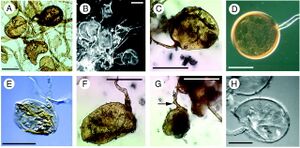The Mycorrhizal Network
By Freya Beinart
Introduce the topic of your paper. What is your research question? What experiments have addressed your question? Applications for medicine and/or environment?
Introduction
Mycorrhizae is the symbiotic relationship between fungi and plants. Mycelium, the vegetative part of a fungus, extends in a branching network of hyphae that secrete enzymes, breaking down organic material into nutrients for its own growth. The vast mycelial branches of the fungi are made of branching networks of hyphae which, in a mycorrhizal association, colonize the root systems of many plant species, greatly increasing the surface area of a plant’s rhizosphere in which it collects water and essential nutrients. In exchange for these nutrients, the plants provide the fungi with carbohydrates that the fungi cannot produce on its own, being heterotrophic.The hyphae of soil fungi colonize the root system of plants, providing the photosynthetic organisms with nutrients and water in exchange for carbohydrates that the heterotrophic fungi cannot produce on its own. This colonization may be intracellular as arbuscular mycorrhizal fungi (AMF) which trade nutrients via a signal transduction pathway, or extracellular as ectomycorrhizal fungi that envelop plant roots.
Types of Mycorrhizal Associations
Endomycorrhizae
Arbuscular mycorrhizal fungi
Fungi of the phylum Glomeromycota that forms mutualistic symbioses, called arbuscular mycorrhizae (AM), with vascular plants are referred to as arbuscular mycorrhizal fungi, or AMF.
Ectomycorrhizal fungi
Ericoid mycorrhizae
Evolution of Mycorrhizae
Fossil records indicate that mycorrhizal fungi predates the evolution of vascular plants, about 460 million years ago in the Ordovican period [1]. The most ancestral mycorrhizal fungi has been identified as arbuscular, penetrating the root cortical cells in most extant plant taxa. The phylum of fungi that associates with land plants as arbuscular mycorrhizal fungi (AMF) is that of Glomeromycota [2](Schüβler, Schwarzott, & Walker, 2001) The presence of these fungi were involved in the development of soil and the evolution and colonization of vascular land plants, specifically by aiding the non-vascular plants with acquisition of nutrients through fungal hyphae, as the “soil” lacked a significant amount of nutrients for terrestrial plants to survive without their fungal symbionts [3]. As the fungi cycles nutrients such as nitrogen, phosphorus, and sulfur to the plants, the fungus receives and fixes carbon into the ground, assisting in the lowering of atmospheric CO2 leading to the oxygenation of the atmosphere during the development of terrestrial plants [4] [5]. In a study by Krings et al (2007) fossil evidence from the Rhynie chert sediment of the Early Devonian period suggests that fungal endophytes, specifically those which colonize the rhizoids of Nothia aphylla, actively influenced the evolution of these plants due to observed host responses. The responses to fungal infection in N. aphylla - rhizoid bulging, separation of infected cells via thickening of cell walls, and the motile inhibition of hypha - suggests its susceptibility to colonization by fungi at least 400 million years ago, advancing selection between plant species with the increasing complexity of interspecies interactions [6].

Biogeochemical Cycles
Applications
References
- ↑ Redecker, D., Kodner, R., & Graham, L. E. (2000). Glomalean fungi from the Ordovician. Science, 289(5486), 1920–1921. doi: 10.1126/science.289.5486.1920
- ↑ Schüβler, A., Schwarzott, D., & Walker, C. (2001). A new fungal phylum, the Glomeromycota: phylogeny and evolution. Mycological Research, 105(12), 1413–1421. doi: 10.1017/S0953756201005196
- ↑ Pirozynski, K. A., & Malloch, D. W. (1975). The origin of land plants: a matter of mycotrophism. Bio Systems, 6(3), 153–164. doi: 10.1016/0303-2647(75)90023-4
- ↑ Mills, B. J. W., Batterman, S. A., & Field, K. J. (2018). Nutrient acquisition by symbiotic fungi governs Palaeozoic climate transition. Philosophical Transactions of the Royal Society of London. Series B, Biological Sciences, 373(1739). doi: 10.1098/rstb.2016.0503
- ↑ Strullu-Derrien, C., Selosse, M.-A., Kenrick, P., & Martin, F. M. (2018). The origin and evolution of mycorrhizal symbioses: from palaeomycology to phylogenomics. The New Phytologist, 220(4), 1012–1030. doi: 10.1111/nph.15076
- ↑ Krings, M., Taylor, T. N., Hass, H., Kerp, H., Dotzler, N., & Hermsen, E. J. (2007). Fungal endophytes in a 400-million-yr-old land plant: infection pathways, spatial distribution, and host responses. The New Phytologist, 174(3), 648–657. doi: 10.1111/j.1469-8137.2007.02008.x
Authored for BIOL 238 Microbiology, taught by Joan Slonczewski, 2021, Kenyon College.
